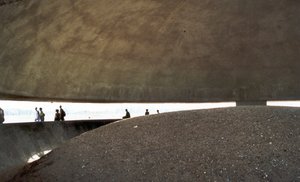Majdanek
|
|
Majdanek_piece.jpg
Majdanek is the site of a Nazi concentration and extermination camp, roughly four kilometers away from the center of the Polish city Lublin. Unlike many other Nazi concentration and extermination camps, Majdanek is not hidden away in some remote forest or obscured from view by natural barriers, nor was it surrounded by a "security zone". It was established in October 1941, at Heinrich Himmler's orders, following his visit to Lublin in July 1941. Majdanek was an SS-run prisoner-of-war camp, under the command of Karl Otto Koch. In February 1943, it was turned into a concentration camp.
In October 1942, several female SS troopers arrived from the Ravensbruck camp in Germany, where they were trained. These women included Elsa Erich, Hermine Braunsteiner, and Rosy Suess. Elisabeth Knoblich was one of the rutheless overseers in the camp. She was so brutal and sadistic that even her fellow Aufseherin feared her and nicknamed her "Halt Die Klappe" (Shut Your Mouth!). When the Soviets liberated Majdanek, they found unending evidence that pointed to the rutheless attitude of the female overseers.
Its name derives from a Lublin district called Majdan Tatarski, and was given it in 1941 by the locals, who were certainly aware of its existence. The original German name of the camp was "Konzentrationslager Lublin" (Concentration Camp Lublin).
At its peak operation, it held about 50,000 inmates. In the early months of 1942, plans were made and approved to expand Majdanek to contain as many as 250,000 inmates. Between April 1942 and July 1944, extermination took place in Majdanek using gas chambers and crematoria. Madjanek was one of two death camps that used Zyklon B in its gas chambers. However, Carbon Monoxide was also used.
According to the data from the official Majdanek State Museum (see external link below) about 300,000 inmates passed through the camp, with over 40% Jews and about 35% Poles. Other major nationalities included Belorussians, Ukrainians, Russians, Germans, Austrians, French, Italians and Dutch. It is estimated that over 235,000 human lives were lost in Majdanek, including about 100,000 Jews. Majdanek was unique among the death camps in that the Jewish victims did not form an overwhelming majority.
Majdanek provided slave labor for munitions works and the Steyr-Daimler-Puch weapons factory.
The camp was liquidated in July 1944, but the crematoria was all that could be destroyed before the time the Red Army arrived, making Majdanek the best preserved camp of the Holocaust. Although 1,000 inmates were evacuated on a death march, the Red Army found thousands of inmates, mainly POWs, still in the camp and ample evidence of the mass murder that had occurred there.
There is a permanent display of a large pile of shoes seized from Madjanek victims at the United States Holocaust Memorial Museum.
Camp commanders
- Karl Otto Koch (September 1941 to July 1942)
- Max Koegel (August 1942 to October 1942)
- Hermann Florstedt (October 1942 to September 1943)
- Martin Weiss (September 1943 to May 1944)
- Arthur Liebehenschel (May 1944 to July 22, 1944)
Sources and further reading
- Official Majdanek Museum (http://majdanek.pl/en/)
- Communique of the Polish-Soviet Extraordinary Commission for Investigating the Crimes Committed by the Germans in the Majdanek Extermination Camp in Lublin (http://www.jewishgen.org/ForgottenCamps/Camps/MajdanekReport.html)
- An overview of Majdanek at about.com (http://history1900s.about.com/library/holocaust/aa092099.htm)
- "Majdanek and Lublin", United States Holocaust Memorial Museum (http://www.ushmm.org/wlc/article.php?lang=en&ModuleId=10005190)de:KZ Majdanek
fr:Majdanek it:Campo di concentramento di Majdanek he:מיידנק nl:Majdanek ja:マイダネク pl:Majdanek

